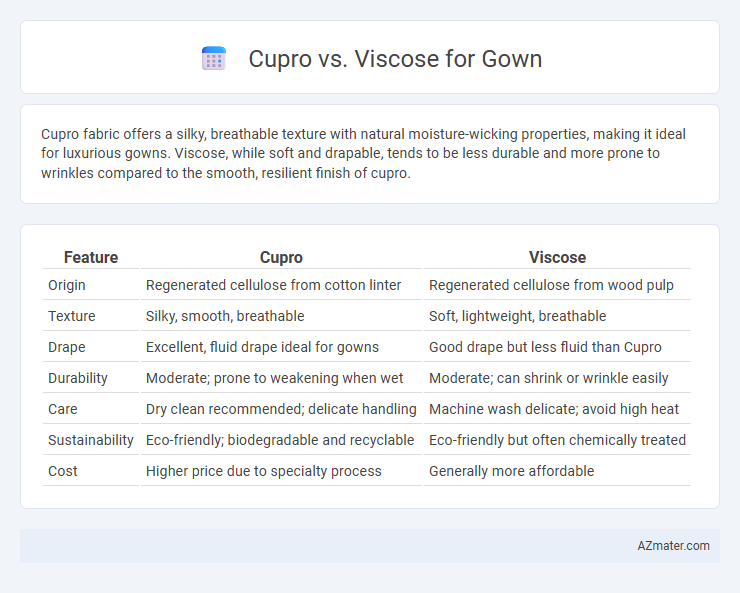Cupro fabric offers a silky, breathable texture with natural moisture-wicking properties, making it ideal for luxurious gowns. Viscose, while soft and drapable, tends to be less durable and more prone to wrinkles compared to the smooth, resilient finish of cupro.
Table of Comparison
| Feature | Cupro | Viscose |
|---|---|---|
| Origin | Regenerated cellulose from cotton linter | Regenerated cellulose from wood pulp |
| Texture | Silky, smooth, breathable | Soft, lightweight, breathable |
| Drape | Excellent, fluid drape ideal for gowns | Good drape but less fluid than Cupro |
| Durability | Moderate; prone to weakening when wet | Moderate; can shrink or wrinkle easily |
| Care | Dry clean recommended; delicate handling | Machine wash delicate; avoid high heat |
| Sustainability | Eco-friendly; biodegradable and recyclable | Eco-friendly but often chemically treated |
| Cost | Higher price due to specialty process | Generally more affordable |
Introduction to Cupro and Viscose
Cupro, a regenerated cellulose fabric derived from cotton linter, offers a silky, breathable texture ideal for gowns, enhancing comfort and drape. Viscose, also a cellulose-based fiber made from wood pulp, boasts a soft feel and excellent moisture absorption, making it a popular choice for elegant, flowy gowns. Both fabrics provide sustainable alternatives to traditional synthetics, with Cupro typically exhibiting a smoother finish and Viscose often providing greater versatility in fabric weight and texture.
What is Cupro Fabric?
Cupro fabric is a regenerated cellulose fiber derived from cotton linter, known for its silky texture and breathability, making it ideal for luxurious gowns. It offers superior moisture absorption and a smooth finish that mimics silk while being more sustainable and biodegradable compared to viscose. Cupro gowns provide a lightweight, anti-static drape with excellent color retention and durability, distinguishing them from viscose alternatives.
What is Viscose Fabric?
Viscose fabric, a semi-synthetic fiber made from regenerated cellulose, offers a silky texture and excellent breathability, making it ideal for gowns requiring softness and comfort. Compared to Cupro, viscose provides a lightweight, drapey feel with high moisture absorption, enhancing wearability in warm climates. Its ability to mimic natural fibers while maintaining affordability makes viscose a popular choice for elegant yet breathable gowns.
Eco-Friendliness: Cupro vs Viscose
Cupro, derived from cotton linter, is highly biodegradable and involves less chemical processing compared to viscose, making it an eco-friendlier choice for gowns. Viscose production often relies on chemically intensive processes and wood pulp from unsustainable sources, contributing to deforestation and water pollution. Choosing Cupro supports lower environmental impact through closed-loop production systems that recycle chemicals and minimize waste.
Texture and Feel Comparison
Cupro fabric offers a silky, smooth texture with a breathable and lightweight feel, making it ideal for gowns that require a luxurious drape and softness against the skin. Viscose, while also soft and breathable, tends to have a slightly more matte finish and can feel heavier or less smooth compared to Cupro, which may affect the fluidity of gown designs. Both materials excel in comfort, but Cupro's silk-like texture provides a more premium, elegant touch suited for high-end gowns.
Durability and Longevity
Cupro fabric offers superior durability and longevity compared to viscose, as it is made from regenerated cellulose fibers with a tighter weave that resists wear and tear more effectively. Viscose tends to weaken and lose structural integrity faster due to its lower resistance to moisture and abrasion during prolonged use. Choosing cupro for gowns ensures longer-lasting garments with maintained softness and strength over time.
Breathability and Comfort for Gowns
Cupro fabric offers superior breathability and moisture-wicking properties compared to viscose, making it an excellent choice for gowns worn in warm or humid conditions. Unlike viscose, which can retain heat and feel less breathable over time, cupro provides a soft, smooth texture that enhances comfort during extended wear. Its natural cellulose fibers promote airflow and reduce skin irritation, ensuring gowns remain cool and comfortable throughout use.
Draping Qualities and Aesthetics
Cupro offers exceptional draping qualities with a smooth, silk-like texture that creates fluid, elegant folds, making gowns appear luxurious and sophisticated. Viscose provides a soft, breathable fabric that drapes well but tends to have a slightly heavier weight and less sheen compared to cupro, resulting in gowns with a more matte and natural look. Both fabrics enhance gown aesthetics, but cupro stands out for its lustrous finish and refined drape, ideal for high-end, formal attire.
Price and Availability
Cupro fabric tends to be more expensive than viscose due to its intricate production process and sustainable appeal, making it a premium choice for gowns. Viscose is widely available and budget-friendly, providing an accessible option for designers and consumers seeking affordability without sacrificing softness and drape. Availability of viscose in various weights and finishes makes it versatile, whereas cupro is often found in limited ranges, impacting its accessibility in mass-market gown production.
Which is Better for Gowns: Cupro or Viscose?
Cupro offers a luxurious silk-like feel with excellent breathability and moisture absorption, making it ideal for gowns requiring comfort and elegance. Viscose provides a smooth texture and vibrant drape but tends to wrinkle more easily and may lack the durability of cupro. For gowns prioritizing softness, durability, and eco-friendliness, cupro is generally better, while viscose suits budget-friendly options with a silky appearance.

Infographic: Cupro vs Viscose for Gown
 azmater.com
azmater.com